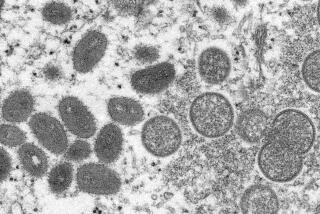British Town’s ‘Mad Cow’ Deaths Prompt Inquiry
- Share via
LONDON — British health officials said Friday that they are investigating a cluster of deaths resulting from the human form of “mad cow” disease around a small town in central England.
Four people who lived in or near the village of Queniborough, in Leicestershire county, have died of Creutzfeldt-Jakob disease, or CJD, in the last two years, and a fifth is believed to have contracted the illness, the government revealed.
Medical authorities said such a cluster is rare and they hope the investigation will shed light on the transmission of the disease. They told villagers not to worry, but they were unable to say whether the outbreak signaled more cases to come.
The victims are believed to have contracted the disease from eating infected meat more than a decade ago, before strict controls were imposed on cattle feed and beef sales, according to health officials.
The incubation period for CJD can be as long as 15 years, and new cases are on the rise in Britain, with 12 registered since January, compared with 13 in all of 1999.
“It’s unlikely that this [Leicestershire outbreak] is a coincidence. But clusters are notoriously difficult to identify and substantiate, which is why we’re having the investigation,” Department of Health spokeswoman Alison Langley said.
The National CJD Surveillance Unit and the London School of Hygiene and Tropical Medicine are helping local authorities investigate the outbreak and to see if there has been any contamination in beef since the 1980s.
CJD is a fatal brain disorder caused by an abnormal protein called a prion. It is rare, hitting only 1 in a million people each year. There is no known cure. It can arise spontaneously with no known source.
An outbreak of a related disorder--bovine spongiform encephalopathy, commonly called mad cow disease--devastated Britain’s cattle industry during the late 1990s. Researchers believe BSE can be transmitted to humans, but the evidence is not conclusive.
While some residents of Queniborough privately voiced concern about the local outbreak, others took the news in stride.
“I think all of this is complete rubbish. I cannot believe that something these people may have got anywhere could have any link to our village,” local neighborhood watch coordinator Rosemary Handley told PA News service.
According to Philip Hunt, a deputy health minister, the four deaths in and near Queniborough compare with a total of 75 deaths throughout Britain. Hunt said in a written report that it was unlikely the high number of cases in Leicestershire could have happened purely by chance.
Health experts have said that genetic susceptibility as well as exposure to the illness plays a role in contracting the disease, and they welcomed the investigation into the Queniborough cluster.
“It may be that the investigation yields some other possible links of causal effect,” said CJD Support Network Chairman Clive Evers.
Dr. Philip Monk, a consultant in communicable diseases at Leicestershire Health Authority, attempted to quell any fears among Queniborough residents, saying it was unlikely that there would be more deaths in the area.
“It is unlikely these cases are linked geographically; rather it was the victims’ genetic susceptibility,” he said. “We are now interviewing the relatives of the victims to try and establish what common connection they may have had.”
More to Read
Sign up for Essential California
The most important California stories and recommendations in your inbox every morning.
You may occasionally receive promotional content from the Los Angeles Times.










